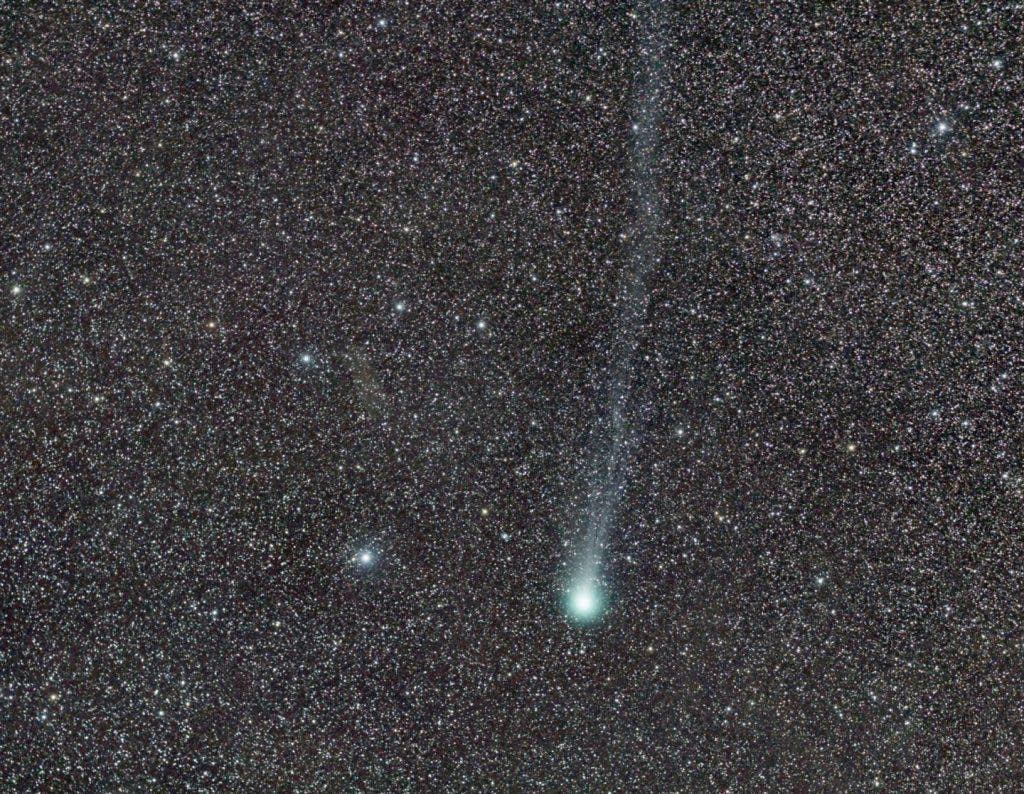True to its name, comet Lovejoy is having a stellar party, releasing large amounts of ethanol, the same type of alcohol found in terrestrial alcoholic beverages – although you probably wouldn’t like to drink it.

It’s the first time scientists have observed ethyl alcohol, the same type in alcoholic beverages, in a comet, and it’s another indication that comets may have been the source of complex organic molecules necessary for the emergence of life as we know it. Astronomers figured this out by analyzing the microwave glow from the comet using the 30-meter (almost 100-foot) diameter radio telescope at Pico Veleta in the Sierra Nevada Mountains of Spain. Sunlight energizes the comet’s atmosphere, causing it to glow at different microwave frequency (if microwaves were visible, then you could think of these frequencies as different colors). Each molecule has a specific, signature frequency, and that’s how you identify what molecules there are on a comet.
“We found that comet Lovejoy was releasing as much alcohol as in at least 500 bottles of wine every second during its peak activity,” said Nicolas Biver of the Paris Observatory, France, lead author of a paper on the discovery published Oct. 23 in Science Advances. The team found 21 different organic molecules in gas from the comet, including ethyl alcohol and glycolaldehyde, a simple sugar.
Comets are frozen remnants from the formation of the solar system. For a while, astronomers have suspected that complex organic molecules can be found on the comets, and it’s potentially these molecules that led to the emergence of life on Earth. Other such molecules were identified on other comets. In July, the Philae lander discovered organic molecules on the comet 67P, including some compounds which could serve as building blocks for life.
The result definitely promotes the idea the comets carry very complex chemistry,” said Stefanie Milam of NASA’s Goddard Space Flight Center in Greenbelt, Maryland, a co-author on the paper. “During the Late Heavy Bombardment about 3.8 billion years ago, when many comets and asteroids were blasting into Earth and we were getting our first oceans, life didn’t have to start with just simple molecules like water, carbon monoxide, and nitrogen. Instead, life had something that was much more sophisticated on a molecular level. We’re finding molecules with multiple carbon atoms. So now you can see where sugars start forming, as well as more complex organics such as amino acids — the building blocks of proteins — or nucleobases, the building blocks of DNA. These can start forming much easier than beginning with molecules with only two or three atoms.”
Now, scientists want to figure out if the comet has been carrying the organic molecules since its formation, from the eve of the solar system, or if they picked them up somewhere along the road.
“The next step is to see if the organic material being found in comets came from the primordial cloud that formed the solar system or if it was created later on, inside the protoplanetary disk that surrounded the young sun,” said Dominique Bockelée-Morvan from Paris Observatory, a co-author of the paper.
Determining that life was “seeded” by comets would be a monumental finding, although it will be borderline impossible to prove, at least with today’s technological possibilities.






